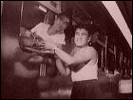The Chase
- Year
- 1957
- Original title
- Harikomi
- Japanese title
- 張込み
- Director
- Cast
- Running time
- 116 minutes
- Published
- 22 April 2002


by Nicholas Rucka
There is a slight debate over whether Harikomi should properly be considered as a film noir piece. On the surface the film has the basic elements that define the genre: moody black and white photography, a murder mystery, an elliptical manner of revealing important plot points, and a seemingly low budget.
Additionally, the film was created by the purportedly 'famous Japanese detective film trio - director Yoshitaro Nomura, screenwriter Shinobu Hashimoto and mystery writer Seicho Matsumoto' (according to the NYC Japan Society 'Dark Visions: Japanese Film Noir and Neo-Noir' program notes). But this being said, I would argue that while the film has many similarities in subject matter and production values to U.S. film noir (due to the limited funding), its content, exposition and pacing is dramatically different. There is, however, little question that director Yoshitaro Nomura and company were influenced by Alfred Hitchcock and, in particular, his 1954 film Rear Window.
But aside from these points, what really makes Harikomi fascinating to watch is its very progressive - especially considering the time of its initial release - social critique, in particular on the marginalization and abuse of women. This is illustrated through the mistreatment and victimization of the housewife Sadako Yokokawa, both by her husband and by the unsympathetic patriarchal Japanese society.
Two police detectives from Tokyo, Yuji Shimaoka (Seiji Miyaguchi) and Takao Yuki (Minoru Ohki), are hot on the trail of the low-life drifter and suspected murderer, Kyuichi Ishii (Takahiro Tamura). After the tail goes cold in Tokyo they use a lukewarm lead to try and nab the suspected murderer at his ex-lover Sadako Yokokawa's (Hideko Takamine) place in a small town in Kyushu. After establishing a stakeout at a ryokan that abuts the ex-lover's house, the police detectives discover, much to their surprise, that Sadako is quite a normal woman. This veil of normality is lifted as the detectives peep how hopeless and grueling Sadako's life really is: her children are abusive and demanding, and her husband is a miser who is so tight with the household funds that Sadako has to supplement her daily allowance to make ends meet by sewing for her neighbors. As a result, the detectives start feeling sorry for Sadako and begin reflecting on their own roles as males in Japanese society.
At least three-quarters of the film passes before the suspected murderer Kyuichi shows up. Rather than being a brusque and violent man, he is instead small and sickly and consumed by tuberculosis. Regardless, Sadako, unaware of the warrant for Kyuichi's arrest, brightens at his return to her life and is prepared to give up everything to be with Kyuichi once more. The detectives meanwhile are in a fix. Though dead set on trying to nail Kyuichi, they are troubled by how much happier Sadako has become now that Kyuichi has returned. The detectives know that justice must be served, but they also realize that with Kyuichi's arrest, Sadako will also be given a jail sentence - as a miserable housewife, trapped in a small town in Kyushu. The detectives are troubled.
The English title of the film is The Chase, but this is a mistranslation. 'Harikomi' actually means 'stakeout', which is far more accurate. But perhaps 'Unjust Life' or 'Marriage Sentence' would be more apt. The film is not fast paced; instead opting for a slower exposition to reveal beautifully defined characterization. By the conclusion the audience knows all about Sadako, Kyuichi and the two detectives. Furthermore, the slow, deliberate pace of the film accentuates the tedium and unhappiness that Sadako faces in her life, making the audience acutely aware of the difficulty the detectives have in choosing their course of action.
Harikomi additionally is shot with exquisite camera movements and lush black and white - there is even one shot that starts with the detectives entering their Tokyo police headquarters, wherein the camera cranes up the outside of the building, following the two men through various offices until they enter their station section. This is essentially the same shot that Italian horror maestro Dario Argento included in his 1982 film Tenebrae but it predates it by 25 years. The use of space and contrast between the 6-tatami-sized ryokan room and the open wilds of Kyushu are also great; Japan was a beautiful place in 1957.
Beyond being a fine piece of social criticism, Harikomi can also be taken as a piece of nostalgia: it's interesting to see how everyday life existed in the Kyushu countryside. Also, the beginning of the film with the two detectives riding the trains from Tokyo all the way to Kyushu is fascinating considering it was in the days before the Shinkansen bullet train.